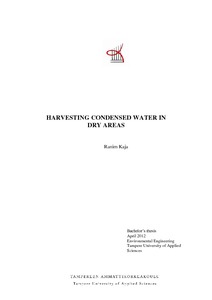Harvesting Condensed Water in Dry Areas
Kaja, Ranim (2012)
Kaja, Ranim
Tampereen ammattikorkeakoulu
2012

Creative Commons Attribution-NonCommercial-NoDerivs 1.0 Finland
Julkaisun pysyvä osoite on
https://urn.fi/URN:NBN:fi:amk-201205249745
https://urn.fi/URN:NBN:fi:amk-201205249745
Tiivistelmä
Water issues have become a disturbing worldwide problem in the current era, but it is more complicated in the arid areas, where it rains rarely and there is hardly any fresh water source at all. Hence, there is a serious need to find new, sustainable, alternative ways to get drinking water.
One of the most interesting methods to get clean water is harvesting humidity from thin air. Many new initiatives have been taken to develop this old way of getting water, and in so many ways it has potential to solve the challenge of getting a new, sustainable and renewable source of fresh water in desert areas.
However, the theme in this thesis will focus on many different ideas and inventions for harvesting humidity. Some of these ideas are very old and very basic, whereas others are more developed and advanced, but all of them are based on the same principle: extracting the humidity particle by making the humid air reaches its dew point. The difference between the different methods is in the way of attracting humidity directly from thin air before the distillation stage. Some of those methods use very simple and cheap ways to hunt humidity from air, which make them the most preferred methods especially in the poorest areas. On the other hand, other methods use very expensive devices; this makes these methods more applicable as investments than as ways of assisting people in arid areas to get water to drink.
Nevertheless, these ideas, devices, and prototypes still need lots of development before we can say that the water problem is on its way to being solved, but at least, the existence of this main principle for extracting water from air means that we are on the right path towards solving this serious problem.
One of the most interesting methods to get clean water is harvesting humidity from thin air. Many new initiatives have been taken to develop this old way of getting water, and in so many ways it has potential to solve the challenge of getting a new, sustainable and renewable source of fresh water in desert areas.
However, the theme in this thesis will focus on many different ideas and inventions for harvesting humidity. Some of these ideas are very old and very basic, whereas others are more developed and advanced, but all of them are based on the same principle: extracting the humidity particle by making the humid air reaches its dew point. The difference between the different methods is in the way of attracting humidity directly from thin air before the distillation stage. Some of those methods use very simple and cheap ways to hunt humidity from air, which make them the most preferred methods especially in the poorest areas. On the other hand, other methods use very expensive devices; this makes these methods more applicable as investments than as ways of assisting people in arid areas to get water to drink.
Nevertheless, these ideas, devices, and prototypes still need lots of development before we can say that the water problem is on its way to being solved, but at least, the existence of this main principle for extracting water from air means that we are on the right path towards solving this serious problem.
